Creon Upton – 4 February, 2011
In choosing to create these particular works Hemer has deprived himself of all compositional freedom beyond the purely formal. By doing little more than stencils, immediately the romantic question of worth raises its head. Is it a statement? A rebellion? A comment? Is one of these bar-codes going to direct me to, like, the dirtiest porn site in the universe or something? Please, Art, titillate me.
Christchurch
André Hemer: hyper/links
Seung Yul Oh in collaboration with Jeff Nusz: Bok
26 January - 27 February 2011
Get off the internet.
- Le Tigre
Strictly speaking, the internet is a proper noun and should be spelt with a capital i: the Moon; the Ganges; John Hurrell; the Internet. But really: that sits so ill, sentimentally speaking, when we are referrring to what has become the great destroyer of upper-case spelling - just one of the many reasons we love it. Requiring that the internet itself contain an upper-case letter is like how Ministers of the Crown can expect to be called Honourable. Just inherently wrong.
Of course, we love the internet for other things too, beyond the assaults on punctuation and syntax that it has both enabled and demanded. In fact, it really is a good thing that the internet came along. Back in like 1993 there was a major crisis brewing (but never named or adverted to at all) in many bourgeois households: the purchase of home computers was becoming more de rigueur by the day, as rumours spread that these machines would make children more intelligent and adults, um, better able to manage their finances or something.
But as you can imagine, once everybody had become thoroughly bored with playing onscreen solitaire - which is only slightly more mundane than playing it with cards - they were left with an embarrassing white elephant in the room, the only tangible benefit of which phenomenon has been, years later, to enable me to not-very-cleverly combine two figures of speech into one - just then, earlier in this sentence….
Thank god - or geeks - or the American military - or whatever it was - for the internet. I mean, we probably wouldn’t have 20/20 cricket without the internet. Think about it.
And we certainly wouldn’t have mobile tagging or object hyperlinking.
For those readers unfamiliar: in brief, a two-dimensional bar-code, such as a QR code, is displayed in the real world, like on a business card; an interested consumer scans the code using their iphone or whatever - having already downloaded a decoding application - and their web browser is directed to the encoded url, so they can peruse the business card’s owner’s website there and then, like, in the moment. (Or other stuff can happen, like calling a particular phone number etc.)
It’s obviously kind of interesting - seriously - removing the heretofore quite incontrovertible demarcation between actions in the physical and online worlds (a relatively big deal I think - and as a marketing thing it’s almost guaranteed to grow).
So anyway, although the Wikipedia page on QR codes, linked to above, has undergone change even during the course of my researching this review, the section on the codes’ use as artwork should be updated now to include a reference to André Hemer’s current show at The Physics Room, where the painter, better known for less geometrical and less monochromatic abstractions, presents a bunch of barcodes that, if you have your appropriately kitted-out phone with you, will send you around cyperspace on an artist-curated tour of webpages depicting the following works: JMW Turner’s Tintern Abbey; a Sol LeWitt wall drawing; a Sol LeWitt certificate of authenticity (employing a quite different-looking Microsoft code, not a QR code); Paul McCarthy’s Michael Jackson Fucked Up (Big Head); Robert Rauschenberg’s Erased de Kooning Drawing (there’s also an identical painting/code adjacent to this that Hemer has himself “erased”, thus breaking the link); and Cory Arcangel’s extremely cool Super Mario Clouds.
And if you climb up the outside wall of the gallery you’ll be able to get a shot of a barcode that will take you to Seung Yul Oh’s Rain (a collaboration with Jeff Nusz), which is also, concurrently, being exhibited alongside Hemer’s work, in the small gallery space of the Physics Room.
JH has already reviewed Rain, here, but I’d briefly like to add my nickel’s worth. First, yes, you can play the game right now, online, by following the above link (or scaling the wall of the old post office in Chch with your iphone, etc), but for anyone with the opportunity, I’d really recommend going into The Physics Room for the gallery experience. (Say hello and welcome to new Director Stephen Cleland while you’re there.) When it’s quiet and cool, and you’ve got five minutes to spare, and the speakers in the gallery play the gentle notes that your key-tapping generates, and you take the thing slowly and seriously, you can have an experience of the art that - bear with me here - is the art.
By which I mean this. For me, aside from the utterly, utterly charming aesthetics of the work, the great brilliance of Rain is the way it exists only through the audience’s actual, physical engagement, where it emulates, and continues to emulate, the partiality of intentional experience, most particularly in our relationships with technology. There’s a certain, yet quite unknowable, degree of control in your hands; there’s also a certain degree of predetermination. The thing follows a pattern, but only with the right stimuli; and there’s an inevitability about it that drives you forward, compels the compromised logic of your tapping on the keyboard. And the joy - god, I nearly used jouissance, really giving myself away - comes in accepting but delighting in the limited, somewhat unknowable part you play in the unfolding of an ephemeral narrative that is unique but not your own - which you’ve partially enabled, with that familiarly blurry, sliding, thick-rubber-glove-handed command that mirrors so precisely the ways in which you have become accustomed to using a keyboard: finally getting the document to look right by utilising some messy, never-to-be-repeated series of half-blind moves; never learning properly how to use styles in Microsoft Word; copying and pasting your way to a good-enough result; googling bizarre combinations in an effort to refind that obscure blog you remember from three months ago; following the same seven-step series of hyperlinks because you know, goddamit, that at least this worked last time.
Ok, and sure, you can have this experience of Rain at home too, online. Just please, treat it with a bit of reverence, set your speakers up, turn the tv off, take your time, be alone: it is Art, after all.
And speaking of Art, Hemer’s “other” show - the curated one, the one that the barcodes link to - is a slightly messy (it’s the internet after all), eclectic exploration of the great modern battle that occurs around, through, and within those supposedly antithetical art-strains, the romantic and the formal-conceptual, a battle that is constantly referenced in Hemer’s work, where grand, colourful, explosive schemes are leavened by the artist’s obedience to the contingency of generated forms.
The basic problem is that the more bold the conceptual gesture, the more likely it is to be co-opted by the basic, underlying romanticism of this age.
The point is illustrated with a supreme lack of irony by Robert Rauschenberg in the video clip found at the bottom-right of the webpage displaying the erased de Kooning. The aged, celebrated, now-sanctioned Art Figure gives an unselfconsciously made-for-tv dramatic account of the meeting between the two men, where the young upstart Rauschenberg proposes his idea and requests a work for the purpose, while the hard, uncompromising de Kooning makes him squirm for his impetuousness (and, by implication, brilliance) before acceding to the adventure by heroically sacrificing a valued work - a true “Earn this!” moment (replete with the two pioneers hammering out the deal over a bottle of Jack Daniels).
I don’t want to go through each of Hemer’s selections, forcing them precisely into my story, but from the Turner (quite conceivably an early, romantic influence on the artist), through to the Arcangel (like Hemer, an artist seemingly distrustful of “creation”, preferring to work with the digitally ready-made and contingent), there seems to be a narrative here about the way fame and fortune and the popular context of art force it into a cloak that tells back to us all our less sophisticated notions about the artist’s endeavour.
In choosing to create these particular works Hemer has deprived himself of all compositional freedom beyond the purely formal. (This is I’m sure by no means a new move in the world of art - but, yes, apparently some folks do require that conceptual gestures all be fresh and new, without, however, also noting - in the same disparaging tones - the done-before-ness of, say, representations of human forms, in oil, on canvas.) But anyway, with the artist doing little more than stencils, immediately that romantic question of worth raises its head. Is it a statement? A rebellion? A comment? Is one of these bar-codes going to direct me to, like, the dirtiest porn site in the universe or something? Please, Art, titillate me.
Hemer’s willing abandonment of autonomy reminds me of Raymond Roussel, a well-born, drug-addicted, literary Frenchman who in the early twentieth century foreshadowed the spirit of modernism with a writing “technique” that left him almost entirely at the mercy of linguistic chance and that was, unsurprisingly, literally laughed off the stage. (Note the familiar romantic strains seeping into the story here.) (Re)discovered by, notably, André Breton and then John Ashbery, the importance of Roussel as an embodiment of a modern, formalist thrust - where artists claim their work back from its bourgeois masters - is fairly well established today (and his writing is sweet).
But like the audience who engages with (and thereby creates) Seung Yul Oh’s Rain - and unlike Roussel in his own day - an artist like Hemer, at least in the context in which he works and exhibits, is able to slide around in the middle ground between contingency and control, playing both creator and created, wearing the masks of both artist-exploring-space and artist-exploring-his-self. He can happily indulge in these clever, slightly interesting formalistic games, while the Creative Soul in him yet announces itself through the wit and assuredness of his chosen moves.
(It’s almost inevitable that any worker in a creative medium will find themselves pushed in the formalistic direction - at some point, to some extent: it’s just unfortunate that the romantic mythologies built up around experimentation and theoretical gesture have a tendency to impel some artists in that direction, less because there’s a compelling logic to it arising out of their work, than because of the intellectual credibility it falsely promises. This is not the case here, however: I just wanted to close with a rant.)
Creon Upton
Recent Comments
Luke Munn
Thanks Creon for this thoughtful, considered review of Rain. Point well made about this thick rubber glove keyboard mashing mirroring ...
John Hurrell
I think the barcode on the outside of The Physics Room is a new development. As for double dipping? If ...
Andrew Paul Wood
Does anyone else think it a little odd that "Bok" the exhibition only consists of "Rain", and that "Rain" is ...
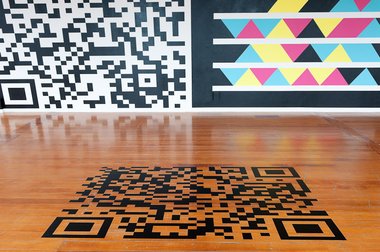
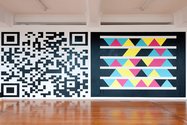
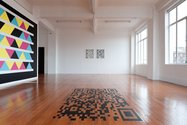



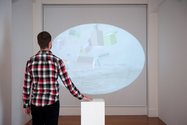
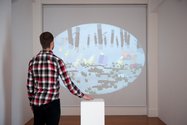
 Advertising in this column
Advertising in this column Two Rooms presents a program of residencies and projects
Two Rooms presents a program of residencies and projects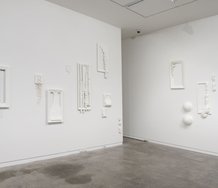
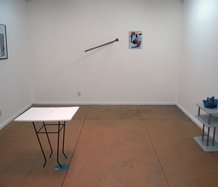
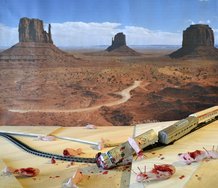
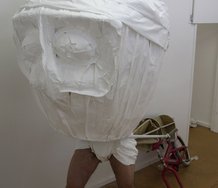
This Discussion has 3 comments.
Comment
Andrew Paul Wood, 4:31 p.m. 4 February, 2011 #
Does anyone else think it a little odd that "Bok" the exhibition only consists of "Rain", and that "Rain" is showing more or less simultaneously at The Physics Room, Christchurch and Artspace, Auckland? Is that double dipping?
John Hurrell, 4:53 p.m. 4 February, 2011 #
I think the barcode on the outside of The Physics Room is a new development.
As for double dipping? If shows normally travel from city to city but this one can be seen simultaneously, then that fact is the point is it not? There is nothing to be transported. (Maybe a disc?) The necessary gear is already set up in the venue.
Luke Munn, 8:45 p.m. 4 February, 2011 #
Thanks Creon for this thoughtful, considered review of Rain.
Point well made about this thick rubber glove keyboard mashing mirroring the unnatural physical knots and timings of keyboard shortcuts, of partial control and frustrated technology-use.
Actually for me this control scheme oversteps this eventually, becoming a keyboard (in musical and play sense) - freeing not functionality-driven, dependent on energy stabbed into it, not precise Ctrl+Shift+X combinations.
Appreciate the recommendation for a slow experience of the work too - something missed many times in interactive and networked pieces, and something we hope to achieve with our commissioning, curating, and presenting of the Screens (www.screens.org.nz) online series.
Participate
Register to Participate.
Sign in
Sign in to an existing account.